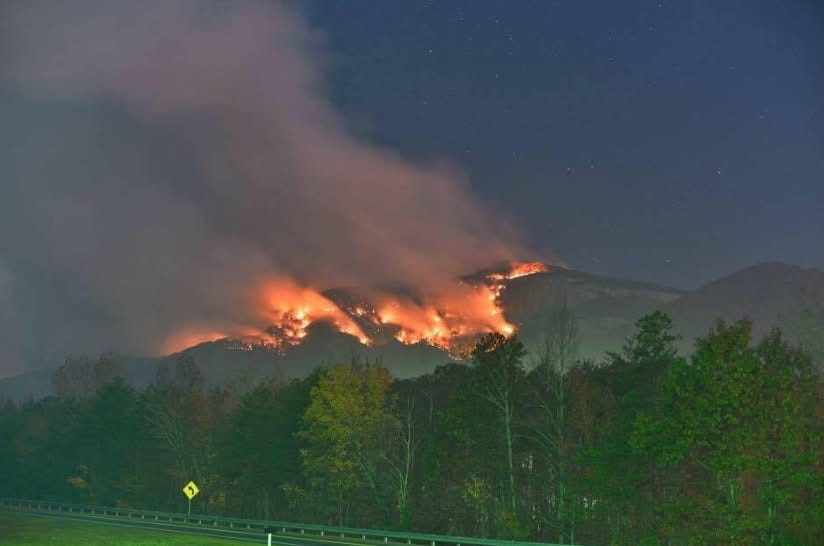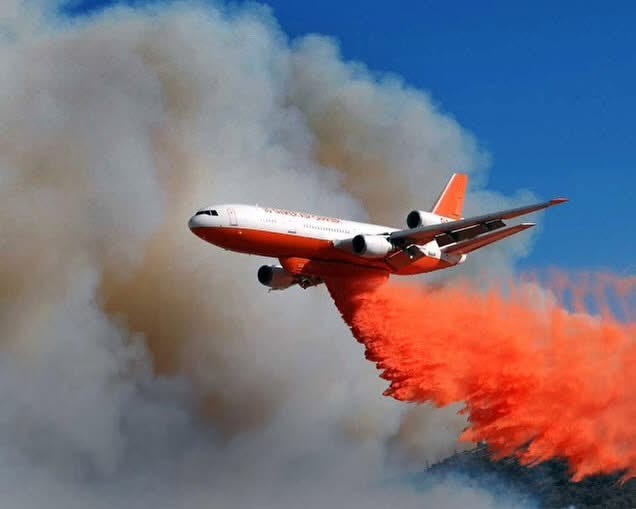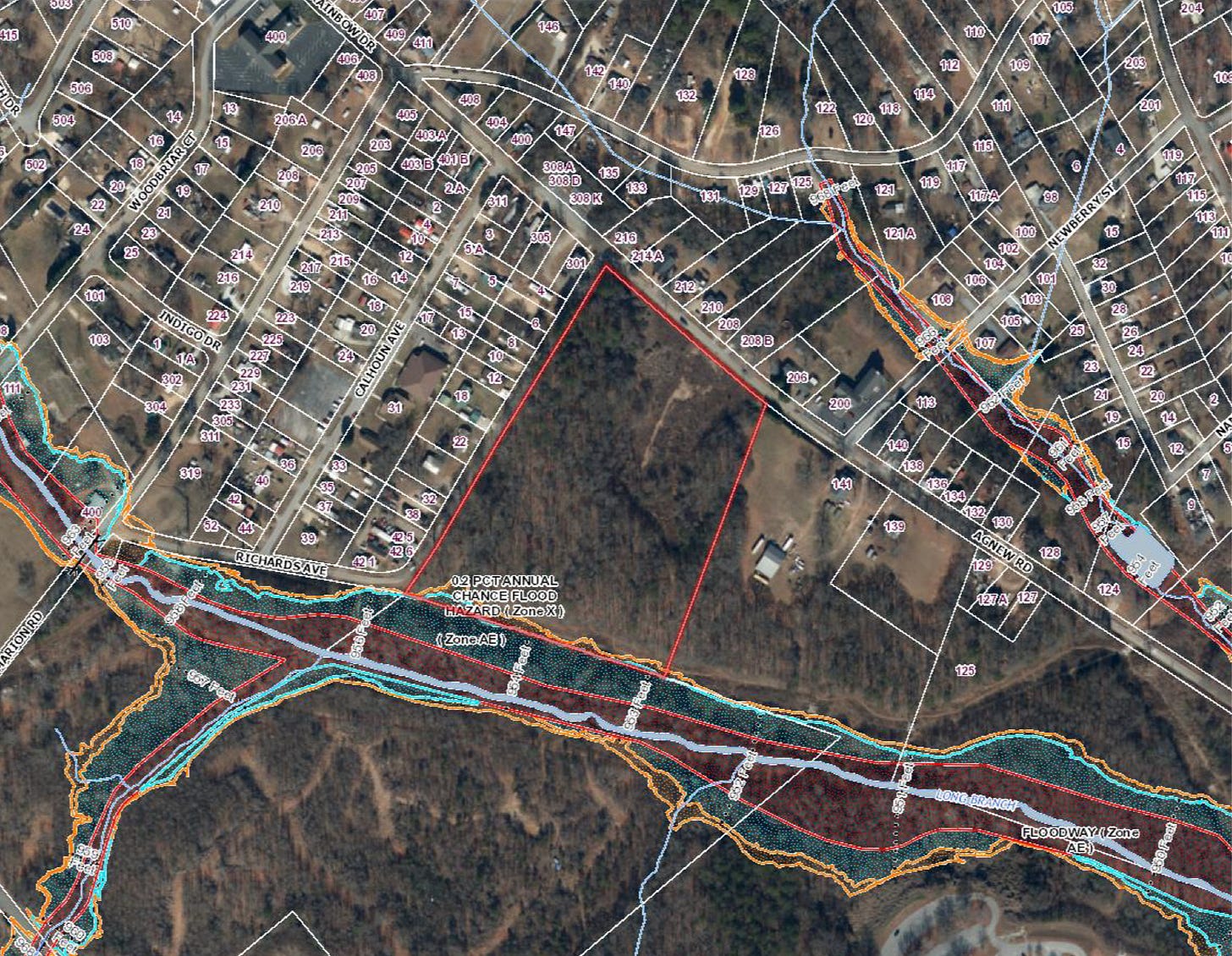Wildfire Updates, Honoring Our Fallen, Citizen Voices Heard, and Flood Plain Issues Addressed
Chairman Blount’s Newsletter 3-30-25
Upcoming Greenville County Council Meetings: March 31 – April 4, 2025
Monday, March 31
5:30 PM – Planning and Development Committee
• Location: 301 University Ridge, Greenville – Committee Meeting Room
• LIVESTREAM - AGENDA
Tuesday, April 1
4:00 PM – Roads, Infrastructure and Public Works Committee
• Location: 301 University Ridge, Greenville – Committee Meeting Room
• LIVESTREAM - AGENDA
5:00 PM – Committee of the Whole
• Location: 301 University Ridge, Greenville – Committee Meeting Room
• LIVESTREAM - AGENDA
6:00 PM – County Council Meeting
• Location: 301 University Ridge, Greenville – Council Chambers
• LIVESTREAM - AGENDA
Progress, Challenges, and Hope in the Table Rock Complex Wildfires
The Table Rock Complex wildfires have now burned over 12,000 acres in Upstate South Carolina, making this the largest wildfire event in the region’s recorded history. As of the latest reports, containment remains modest but steadily improving. The Table Rock Fire is about 10,904 acres and 9% contained, and the Persimmon Ridge Fire is roughly 2,078 acres and 24% contained. Fire officials note that these figures are expected to rise as rain and extensive firefighting efforts slow the fire’s spread. This wildfire complex was declared the nation’s #1 priority fire late last week, ensuring that resources from across the country are being concentrated here.
In Greenville County, a mandatory evacuation remains in place for the far-northwestern corner of the county, roughly north of the Greenville-Pickens County line, west of Wildcat Falls along Hwy 11/276, and east of the Table Rock Reservoir. This includes many rural mountain roads and neighborhoods (such as areas around Caesar’s Head and the South Saluda Road region). Residents in this zone must not return home yet, as authorities warn that changing conditions could force another evacuation if the fire flares up again.
Firefighting Response
Combating the Table Rock Complex fires has truly been a multi-agency effort with support from local crews, state resources, federal teams, and nonprofit organizations. All partners are working around the clock to contain the fires and protect our community.
Firefighters are attacking the blazes on multiple fronts. On the ground, bulldozers and hand crews have cut extensive firebreaks through the forests to stop the fire’s spread. In some cases, crews utilized firebreaks established during the Pinnacle Mountain Fire of 2016, clearing out the re-grown vegetation and fallen timber from Hurricane Helene to reuse those lines. Where accessible, bulldozers have plowed lines. In steeper areas, crews are working with chainsaws and rakes to create buffers. Structure protection units remain staged in neighborhoods just outside the fire line – firefighters have been literally camped out by homes in the line of fire. In one instance on Sky Ranch Road in northern Greenville County, teams stood guard around a home as flames approached; when embers ignited the area a second time, crews and a DC-10 air tanker swiftly doused the flames and saved the house.
Aircraft have been critical
National Guard helicopters are scooping water from local lakes for drops, and fixed-wing aircraft (single-engine air tankers, large tankers, and the VLAT) have been dropping long lines of retardant ahead of the fire. Retardant drops, in particular, were used to “paint” a box around the Persimmon Ridge Fire to prevent it from escaping its containment lines, especially along Oil Camp Creek Road on the fire’s north side. Officials emphasize that with so many aircraft in the sky, it’s crucial for private drones to stay grounded – a no-fly order is in effect for civilian drones so they don’t interfere with firefighting planes.
Latest from Forestry Commission – “We’re Getting the Upper Hand”
In an update this morning, Derrick Moore of the Southern Area Blue Team provided an encouraging progress report. He noted that light rain was falling “in the air now” over the fire – not a drenching rain, but enough to “use to get ahead of the fire” and aid firefighters’ efforts. Because of the weather, aviation operations were expected to be limited on Sunday (clouds and drizzle can prevent air tankers and helicopters from flying safely). However, Moore explained they might not need as many air drops now given the reduced fire intensity on the ground. The focus has shifted to aggressive ground work and tightening control lines around the perimeter.
For the Persimmon Ridge Fire, Moore’s update confirmed that it is “in better shape” than its larger counterpart. Firefighters have gained the upper hand there to the point that no additional spread is anticipated for the next few days . They have even declared the western portion of the Persimmon Ridge Fire contained . On Sunday, some crews that were assigned to Persimmon Ridge were being redeployed to the Table Rock Fire to assist with the remaining hot areas . Officials will continue to patrol the Persimmon Ridge area and respond to any smoke or embers, but there is growing confidence that this fire will not threaten any more homes. Its containment percentage (24% as of Saturday) should climb as crews mop up along the edges.
Overall, the tone of the latest briefing was one of cautious optimism. “We expect the fire to slow down or stop growing due to the rain,” Moore said, reflecting a belief that the worst rapid fire growth is behind us. Firefighters are remaining vigilant, as winds could always pick up or dry weather could return, but every indication on Sunday was that the situation was stabilizing. SC Forestry Commission officials stress that they will not consider the incident fully under control until robust containment lines encircle the entire fire and all remaining hot spots are extinguished. That work – including patrolling, extinguishing smoldering logs, and felling hazardous burnt trees – will continue over coming days even once the flames are no longer advancing.
Listen to the update HERE
In the meantime, the community can help by staying informed and following guidance from authorities. Greenville County is providing updates through its Emergency Management social media, and the SC Forestry Commission and firefighting team will release new information as containment progresses.
In summary, thanks to the immense effort of firefighters and some help from Mother Nature, the Table Rock Complex wildfires are no longer spreading out of control. Containment is improving each day. Local, state, and federal partners – along with nonprofit groups and volunteers – have mounted an extraordinary response to protect our Greenville County communities. While some challenges remain until the fires are fully out, officials are increasingly confident that with continued diligence and favorable weather, these wildfires will be brought to heel soon. Evacuated families should hold tight a bit longer until given the all-clear, and everyone in the county should remain cautious and avoid the fire areas. We will continue to provide updates on containment progress, lifting of evacuation orders, and any important changes. For now, please keep our firefighters and first responders in your prayers as they work to fully secure the fire lines in the days ahead – and join us in hoping for a good soaking rain to finally put an end to the Table Rock Complex fires!
Residents can call the Table Rock Complex Information Line at 803-906-9730 for fire status information.
Honoring Sergeant Conley Jumper: Supporting the State Resolution to Designate “Sgt. W.C. Jumper Highway”
This week, I will introduce a resolution to support a concurrent resolution introduced in the South Carolina General Assembly. This state-level resolution seeks to designate a portion of Interstate 85, from mile marker 41 to mile marker 42 in Greenville County, as “Sgt. W.C. Jumper Highway”. Our local resolution aims to express Greenville County’s full support for this initiative, honoring the dedicated service and ultimate sacrifice of Sergeant Conley Jumper.
On March 5, 2025, members of the South Carolina House of Representatives introduced House Concurrent Resolution 4150 (H. 4150). This resolution requests that the South Carolina Department of Transportation name the specified section of I-85 in honor of Sergeant Jumper and erect appropriate markers or signs to reflect this designation. The resolution has been referred to the House Committee on Invitations and Memorial Resolutions for further consideration.  
Sergeant Conley Jumper: A Legacy of Service
Sergeant William Conley Jumper Jr. dedicated 28 years to the Greenville County Sheriff’s Office, serving with distinction and unwavering commitment to public safety. As a member of the Sheriff’s Office Interdiction Team, Sergeant Jumper was instrumental in combating drug trafficking along Interstate 85, a known corridor for such activities. Tragically, on October 20, 2020, Sergeant Jumper lost his life in the line of duty during a traffic stop on I-85 near White Horse Road. His bravery and dedication have left an indelible mark on our community.
Purpose of the County Resolution
The resolution being presented serves to formally express our support for H. 4150 and the state’s efforts to honor Sergeant Jumper. By aligning with the General Assembly’s initiative, we aim to demonstrate unified local and state recognition of Sergeant Jumper’s contributions and sacrifice. This designation will serve as a lasting tribute, reminding all who travel this stretch of I-85 of the profound impact Sergeant Jumper had on Greenville County.
I encourage all community members to support this resolution and the broader initiative to honor Sergeant Jumper. By doing so, we not only commemorate his life and service but also reaffirm our collective commitment to recognizing and supporting the men and women who dedicate their lives to protecting our community.
Partial but Major Victory for Greenville: Senate Unanimously Votes Down Bill 4002 – What’s Next for Our Sanitation Services?
Greenville County has achieved a significant victory as the South Carolina Senate unanimously voted down House Bill 4002 (H. 4002), a bill that aimed to dissolve the Greater Greenville Sanitation District (GGSD). This decision safeguards the essential sanitation services that thousands of our residents and businesses rely upon daily.
Had H. 4002 passed, it would have transferred all powers, duties, responsibilities, assets, and liabilities of the GGSD to the governing body of Greenville County, effectively dismantling the district. This move threatened to disrupt waste collection services, leading to potential increases in costs and a decrease in service reliability for our community.  
In response to the Senate’s decision, I am suggesting to amend our upcoming resolution that opposed both H. 4002 and H. 4003. The amendment will remove all references to H. 4002, reflecting its defeat, while maintaining our firm opposition to H. 4003. This ensures that our official stance remains clear and focused on protecting the services that thousands of residents depend on.
Expressing Gratitude to Our Legislative Delegation
I extend my heartfelt thanks to the members of the South Carolina Senate for their unanimous decision to vote down H. 4002. Your leadership and commitment to the well-being of Greenville County residents through this action has been instrumental in preserving the integrity of our sanitation services. My community and I thank you tremendously for listening to your constituents!
Shifting Focus to House Bill 4003
With H. 4002 behind us, our attention now turns to House Bill 4003 (H. 4003), which still poses a significant threat to the future of GGSD. This bill seeks to impose severe restrictions on the district’s operations, including:
• Limiting services to within district boundaries: This would prevent GGSD from serving areas outside its established boundaries, potentially leaving many residents without reliable waste collection services.
• Restricting services to single-family residential customers: Such a limitation would exclude multi-family residences and businesses from receiving GGSD services, forcing them to seek potentially more expensive private alternatives.
• Eliminating the ability to levy millage for funding: This change would shift the financial burden entirely onto service fees, disproportionately impacting low-income residents and seniors.
• Prohibiting the issuance of bonds: These restrictions would hinder GGSD’s ability to finance necessary infrastructure projects and manage waste effectively.
The passage of H. 4003 could lead to higher costs, reduced services, and a decline in sanitation efficiency, placing undue strain on our community.
Call to Action: Engage in Protecting Our Sanitation Services
I urge all residents of the Greater Greenville Sanitation District to take an active role in opposing H. 4003:
• Contact your state legislators: Express your concerns and ask them to oppose H. 4003.
• Stay informed: Keep up with developments regarding the bill and participate in public discussions.
• Spread the word: Inform your neighbors and community members about the potential impacts of H. 4003 and encourage them to take action.
Together, we can continue to protect and preserve the essential sanitation services that contribute to the health and well-being of Greenville County. While there are still some unknown waters ahead, it it’s evident that when you all come together, elected officials do act on behalf of those voices!
Zoning Decisions: More Complex Than They Seem
Typically, rezoning desires are pretty easy to predict for our district. Today, I want to highlight a current rezoning request that shows how land use decisions are not always that simple.
R-MHP to R-M8
A request has been made to rezone a 12.45-acre parcel at Agnew Rd. & Richards Ave. from R-MHP (Residential Manufactured Home Park District) to R-M8 (Multifamily Residential District). The applicant intends to build attached townhomes in a cluster/open-space development with around 100 total units.
At first glance, a shift from mobile homes to multifamily residential may seem like a straightforward improvement, but the reality is more nuanced.
What Changes With This Rezoning?
1. A Decrease in Allowed Units
• Under the current zoning (R-MHP), the site could accommodate 112 units.
• Under the proposed zoning (R-M8), the maximum drops slightly to 99 units.
It may seem counterintuitive, but this rezoning actually decreases the overall potential housing density—meaning that less total housing could be built than under the current zoning.
2. A Likely Increase in Development Speed
• Manufactured home parks often take longer to establish and fill because they require individual lot sales and setup.
• Townhome developments, on the other hand, can be built and sold much more quickly, meaning that this area could see development sooner than if it remained an R-MHP site.
3. Infrastructure Considerations
• Roads: The site is located on Agnew Road, a two-lane collector road, and Richards Avenue, a local road. Neither has sidewalks or direct access to public transit.
• Traffic Impact: While traffic counts have fluctuated slightly in recent years, additional homes could add more vehicle trips to an already narrow roadway.
• Floodplain Issues: Any development here will have to comply with the county’s Flood Damage Prevention Ordinance, which may affect site layout and stormwater management.
4. Impact on Nearby Schools
• The property sits within a mile of three elementary schools—Alexander Elementary, Monaview Elementary, and Westcliffe Elementary.
• A development of up to 99 units could lead to an increase in school enrollment, something the community has already had concerns about.
What’s Next?
This rezoning request has already received preliminary approval from the Planning Commission and Planning & Development Committee. However, Greenville County Council has the final say.
Before that happens, I want to hear from you.
• Given that a mobile home park of 112 units could be developed with no approval or denial potential from County Council if it remains the current zoning, do you think this rezoning is a good idea?
I will be reaching out to neighbors in the area before the final vote to make sure your voices are heard. If you have thoughts on this, reply to this email or comment in space provided below.
Why This Matters
Most people don’t have time to follow every rezoning request, but these decisions shape the future of our communities. That’s exactly why I started this newsletter—to bring you the key details in a way that fits into your busy life and to make sure your opinions are heard before decisions are final.
I look forward to hearing your thoughts!
SCOR Greenville Public Meeting: A Major Step Forward for Flood Resilience in District 19
This past week, I attended the South Carolina Office of Resilience (SCOR) public meeting at the Berea Public Library, where the team presented their plans for stream improvement, restoration, and reclamation projects in Greenville County. I was very impressed with both the presentation and the thorough planning process behind these initiatives.
For too long, areas of District 19—especially around Vinson/Plano Drive, Dukeland/Langston Drive, and Agnew/Bramlett Road—have struggled with flooding and erosion issues. This meeting made it clear that real, tangible relief is on the way. The Little Creek and North Chastain Stream Improvement Projects are designed to stabilize waterways, reduce flood risks, improve water quality, and enhance the local ecosystem. These efforts will not only protect homes and infrastructure but also help restore natural beauty to these areas.
Who is SCOR and What Do They Do?
The South Carolina Office of Resilience (SCOR) is a state agency dedicated to helping communities prepare for and recover from natural disasters—particularly flooding. SCOR works to improve stormwater management, infrastructure resilience, and environmental restoration to protect South Carolinians from the increasing impacts of severe weather events. Their goal is to create long-term, sustainable solutions that reduce risks, improve water quality, and strengthen the ability of communities to withstand future disasters.
In Greenville County, SCOR has already secured millions of dollars in grants to fund critical flood mitigation and waterway restoration projects, including the Reedy River Watershed improvements. The agency partners with local governments, engineers, and environmental experts to identify problem areas and implement practical solutions.
A Huge Thank You to SCOR, Greenville County Staff, and Project Engineers
I want to extend my sincere gratitude to everyone who put this presentation together and has been working tirelessly to bring these solutions to our community. A special thanks to:
Greenville County Staff:
• Destiny Macon, Land Development Project Manager
• Judy Wortkoetter, County Engineer
South Carolina Office of Resilience (SCOR) Team:
• Pam Kendrick, Infrastructure Program Manager
• Amy Azarias, Infrastructure Project Manager
• Samantha Brooks, Infrastructure Program Coordinator
Woolpert Engineering Team:
• James Riddle, Program Director/Vice President
• Brian Behrens, Project Manager
• Zach Smoot, Project Engineer
Your dedication to addressing flooding, stormwater issues, and long-term community resilience is truly making a difference for residents in District 19 and beyond.
For Those Thinking, “We Could Use This Too”
If you’re reading this and thinking, “We could really use something like this in our area,” you’re not alone. The reality is that many neighborhoods across Greenville County face similar challenges with flooding, stormwater management, and erosion. Hopefully, this is just the next step in a broader effort to address these issues countywide.
In fact, I have some additional news that I’ll be sharing in the coming weeks about partnerships with SCOR that I believe will bring even more relief to flood-prone communities. If you live in an area dealing with floodplain issues, I think you’ll be very encouraged by what’s coming.
I’ll keep you updated as these projects develop, and I encourage you to reach out with your questions or concerns.
I know it was a lot to read, and I thank you if you made it this far, but that’s it for this week’s newsletter! As always, I hope that you and your families have a blessed and prosperous week in Greenville County.












Thank you Benton, I appreciate your tireless efforts! I agree with Mary. One issue with the unmitigated growth is that developers are not improving roadways: acceleration / turnoff lanes, extra traffic lights, etc; especially along the Whitehorse corridor. The upstate is becoming a traffic gridlock on backroads now for commuters.
With regards to SCOR; Saluda lake runoff, specifically down In the area of Motorboat Club Rd, has become a haven for atvs and after dark shooting ranges in the valleys leading to Lake Saluda; thereby blocking up natural runoff. ATT&T and other utilities have run shallow under ground cables in the ditches; not allowing the county to re-trench residential and commercial runoff to existing culverts leading to the lake. In effect, this has caused basement flooding and modifications of residential properties that the county 'should' be responsible for.
God Bless! Bill
Thank you, Benton! I appreciate this newsletter, and hope others do as well!